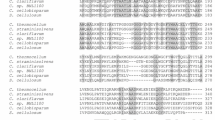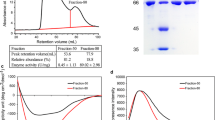Abstract
Caldocellum saccharolyticum is an extremely thermophilic anaerobic bacterium capable of growth on cellulose and hemicellulose as sole carbon sources. Cellulase together on its genome. The gene for one of the cellulases (celA) was isolated on a λ genomic library clone, sequenced and found to comprise a large open-reading frame of 5253 base pairs that could be translated into a peptide of 1751 amino acids. To date, it is the largest cellulase gene sequenced. The translated product is a multidomain structure composed of two catalytic domains and two cellulose-binding domains linked by proline-threonine-rich regions (PT linkers). The N-terminal domain of celA encodes for an endoglucanase activity on carboxymethylcellulose, consistent with its high homology to the sequences of several other endo-1,4-β-d-glucanases. The carboxylterminal domain shows sequence homology with a cellulase from Clostridium thermocellum (CelS), which is known to act synergistically with a second component to hydrolyze crystalline cellulose. In the absence of a Caldocellum homologue for this second protein, we can detect no activity from this domain.
Similar content being viewed by others
References
Appleyard RK (1954) Segregation of new lysogenic types during growth of a doubly lysogenic strain derived from Escherichi coli K12. Genetics 39:440–452
Aubert JP, Béguin PJ Millet J (ed) (1988) Biochemistry and genetics of cellulose degradation. FEMS Symposium no. 43. Academic Press, New York
Bagnara-Tardif C, Gaudin C, Belaich A, Hoest P, Citard T, Belaich J-P (1992) Sequence of a gene cluster encoding cellulases from Clostridium cellulolyticum. Gene 119:17–28
Bankier AT, Weston KM, Barrell BG (1987) Random cloning and sequencing by the M13/dideoxynucleotide chain termination method. Methods Enzymol 155:51–93
Béguin P, Aubert JP (1994) The biological degradation of cellulose. FEMS Microbiol Rev 13:25–28
Bhikhabhai R, Johansson G, Petterson LG (1984) Isolation of cellulolytic enzymes from Trichoderma reesei QM9414. J Appl Biochem 6:336–345
Coughlan MP (1990) Cellulose degradation by fungi. In: Fogarty WM, Kelly CT, (eds) Microbial Enzymes and biotechnology, 2nd edn. Elsevier Applied Science, London, pp 1–36
Devereux J, Haeberli P, Smithies DO (1984) A comprehensive set of sequence analysis programs for the VAX. Nucleic Acids Res 12:387–395
Din N, Gilkes NR, Tekant B, Miller Jr RC, Warren RAJ, Kilburn DG (1991) Non-hydrolytic disruption of cellulose fibres by the binding domain of a bacterial cellulase. Biotechnology 9:1096–1099
Fujino T, Karita S, Ohmiya K (1993) Nucleotide sequence of the celB gene encoding endo-1,4-β-glucanase-2, ORF1 and ORF2 forming a putative cellulase gene cluster of Clostridium josui. J Ferment Bioeng 76:243–250
Gibbs MD, Saul DJ, Lüthi E, Bergquist PL (1992) The β-mannanase from “Caldocellum saccharolyticum” is part of a multidomain enzyme. Appl Environ Microbiol 58:3864–3867
Gilkes NR, Warren RAJ, Miller RC, Kilburn DG (1988) Precise excision of the cellulose binding domains from two Cellulomonas fimi cellulase by a homologous protease and the effect on catalysis. J Bio. Chem 120:97–120
Giorda R, Ohmachi T, Shaw DR, Ennis DHL (1990) A shared internal threonine glutamic acid-threonine-proline repeat defines a family Dictyostelium discoideum spore germination-specific proteins. Biochemistry 29:7264–7269
Hayashida S, Mo K, Hosada A (1988) Production and characteristics of Avicel-digesting and non-Avicel-digesting cellobiohydrolases from Aspergillus ficum. Appl Environ Microbiol 54:1523–1529
Henrissat B, Driguez H, Viet C, Schulien M (1989) Cellulase families revealed by hydrophobic cluster analysis. Gene 81:83–95
Knowles J, Lehtovaara P, Teeri T (1987) Cellulase families and their genes. Trends Biotechnol 5:255–261
Lao G, Gurdev S, Ghangas ED, Wilson J, Wilson DB (1991) DNA sequences of three β-1,4-endoglucanase genes from Thermononospora fusca. J Bacteriol 173:3397–3407
Love DR, Fisher R, Bergqist PL (1988) Sequence structure and expression of a cloned β-glucosidase gene from an extreme thermophile. Mol Gen Genet 213:84–92
Lüthi E, Love DR, McAnulty J, Wallace C, Caughey PA, Bergquist PL (1990) Cloning, sequence analysis and expression of genes encoding xylan-degrading enzymes from the thermophile “Caldocellum saccharolyticum”. Appl Environ Microbiol. 56:1017–1024
Lüthi E, Bhana-Jasmat N, Grayling RA, Love DR, Bergquist PL (1991) Cloning, sequence analysis and expression in Escherichia coli of a gene coding for a b-mannanase from the extremely thermophilic bacterium “Caldocellum saccharolyticum”. Appl Environ Microbiol 57:694–700
Mackay RM, Lo A, Willide G, Zuker M, Baird S, Dove M, Moranelli F, Seligy V (1986) Structure of a Bacillus subtilis endo-β-1,4-glucanase gene. Nucleic Acids Res 14:9159–9170
Meinke A, Braun C, Gilkes NR, Kilburn DG, Miller Jr RC, Warren RAJ (1991) Unusual sequence organization in CenB, an inverting endoglucanase from Cellulomonas fimi. J Bacteriol 173:308–314
Montenourrt BS (1983) Trichodema reesei cellulases. Trends Biotechnol 1:156–161
Navarro A, Chebrou M-C, Béguin P, Aubert J-P (1991) Nucleotide sequence of the cellulase gene celF of Clostridium thermocellum. Res Microbiol 142:927–936
Rainey FA, Ward NL, Morgan HW, Stackebrandt E (1993) A phylogenetic analysis of anaerobic thermophilic bacteria, an aid for their reclassification. J Bacteriol 175:4772–4779
Rouvinen J, Bergfors T, Teeri T, Knowles JKC, Jones TA (1990) The three-dimensional structure of cellobiohydrolase II from Trichoderma reesei. Science 249:380–386
Sambrook J, Frisch EF, Maniatis T (1989) Molecular cloning: a laboratory manual. 2nd edn. Cold Spring Harbor Laboratory Press, Cold Spring Harbor, NY
Saul DJ, Williams LC, Love DR, Chamley LW, Bergquist PL (1989) Nucleotide sequence of a gene from Caldocellum saccharolyticum encoding for exocellulase and endocellulase activity. Nucleic Acids Res 17:439
Saul DJ, Williams LC, Grayling RA, Chamley LW, Love DR, Bergquist PL (1990) celB, a gene coding for a bifunctional cellulase from the extreme thermophile “Caldocellum saccharolyticum”. Appl Environ Microbiol 56:3117–3124
Schauder B, Blöcker H, Frank R, McCarthy JEG (1987) Inducible expression vectors incorporating the Escherichia coli atpE translational initiation region. Gene 52:279–283
Shoemaker S, Schweickart V, Ladner M, Gelfand D, Kwok S, Myambo K, Innis M (1983) Molecular cloning of exocellobiohydrolase I derived from Trichoderma reesei strain L27. Biotechnology 1:691–696
Shoseyov O, Takagi M, Goldstein MA, Doy RH (1992) Primary sequence analysis of Clostridium cellulovorans cellulose binding protein A Proc Natl Acad Sci USA 89:3483–3487
Teather RM, Wood PK (1982) Use of Congo Red-polysaccharide interactions in enumeration and characterization of cellulolytic bacteria from bovine rumen. Appl Environ Microbiol 43:777–780
Tucker ML, Milligan SB (1991) Sequence analysis and comparison of avocado fruit and bean abscission cellulases. Plant Physiol 95:928–933
Tucker ML, Durbin ML, Clegg MT, Lewis LN (1987) Avocado cellulase: nucleotide sequence of a putative full-length cDNA clone and evidence for a small gene family. Plant Mol Biol 9:197–203
Wang WK, Kruus K, Wu J HD (1993) Cloning and DNA sequence of the gene coding for Clostridium thermocellum cellulase Ss (CelS), a maajor cellulosome Component. J Bacteriol 175:1293–1302
Yanisch-Perron C, Vieira J, Messing J (1985) Improved M13 phage cloning vectors and host strains: Nucleotide sequences of M13mp18 and puC19 vectors. Gene 33:103.119
Author information
Authors and Affiliations
Rights and permissions
About this article
Cite this article
Te'o, V.S.J., Saul, D.J. & Bergquist, P.L. celA, another gene coding for a multidomain cellulase from the extreme thermophile Caldocellum saccharolyticum . Appl Microbiol Biotechnol 43, 291–296 (1995). https://doi.org/10.1007/BF00172827
Received:
Revised:
Accepted:
Issue Date:
DOI: https://doi.org/10.1007/BF00172827




